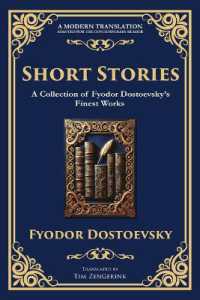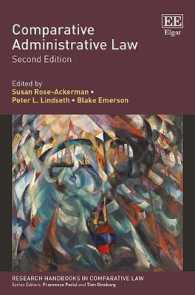- ホーム
- > 洋書
- > 英文書
- > History / World
Full Description
This is an open access title available under the terms of a CC BY-NC-ND 4.0 International licence. It is free to read on the Oxford Academic platform and offered as a free PDF download from OUP and selected open access locations.
Writing from Invention to Decipherment contains a wealth of global scholarship on ancient writing systems from China, Mesopotamia, Central America, and the Mediterranean, to more recent newly created scripts such as the Rongorongo from Easter Island, the Caroline Island scripts, as well as the alphabet. The aim is to dig into the foundations of writing, showcasing the complexities and varieties of scripts, from their invention to the potential decipherment of poorly understood scripts.
The volume offers state-of-the-art research on undeciphered scripts from the Aegean (as for example, Cretan Hieroglyphic and Linear A) or not completely deciphered (as for example Maya) scripts. From a methodological perspective, these contributions lay out how and why writing was invented, who used it, and to what ends. Here writing is presented as a multi-modal cultural phenomenon, that intersects and transcends neat discipline boundaries, within an inclusive approach bridging archaeology, linguistics, epigraphy, and cognitive studies.
Contents
Silvia Ferrara, Barbara Montecchi, and Miguel Valério: Introduction
PART I: BEGINNINGS OF WRITING
1: Mattia Cartolano: Cognition, iconography, and graphic communication systems on portable objects in the Near Eastern Neolithic
2: Paola Demattè: The origins of Chinese writing
3: Aaron J. Koller: The failure and success of the early alphabet
4: Willemijn Waal: Closing the gap: writing in the Aegean from the Late Bronze Age to the Iron Age
5: Alex de Voogt: The Caroline Islands Script: how one script informs five debates
PART II: THE FUTURE OF UNDECIPHERED SCRIPTS
6: Ignasi-Xavier Adiego: Deciphering a writing system: luck, intuition, or method?
7: Judith Weingarten: The cat in the Cretan Hieroglyphic script: ma, what it means, and where it leads
8: Giorgia Baldacci: The Phaistos disk: placing an enigmatic artefact in its cultural context
9: Barbara Montecchi: Design and origins of Linear A picture-based signs
10: Miguel Valério: The Rongorongo 'lunar calendar' of Rapa Nui (Easter Island) and the type of script
PART III: CURRENT APPROACHES TO EARLY WRITING AND READING
11: Christian M. Prager, Katja Diederichs, Antje Grothe, Nikolai Grube, Guido Krempel, Mallory Matsumoto, Tobias Mercer, Cristina Vertan, and Elisabeth Wagner: IDIOM - A digital research environment for the documentation and study of Maya hieroglyphic texts and language
12: Sarah Finlayson: Looking for readers in the Bronze Age Aegean
13: Louis Godart: Looking for writers in the archives of King Nestor








